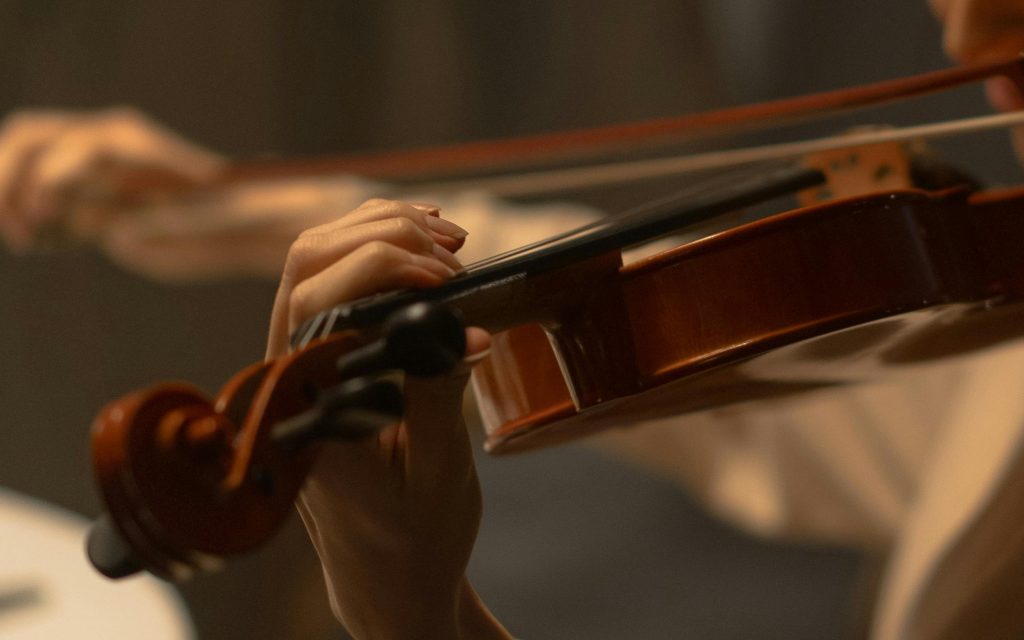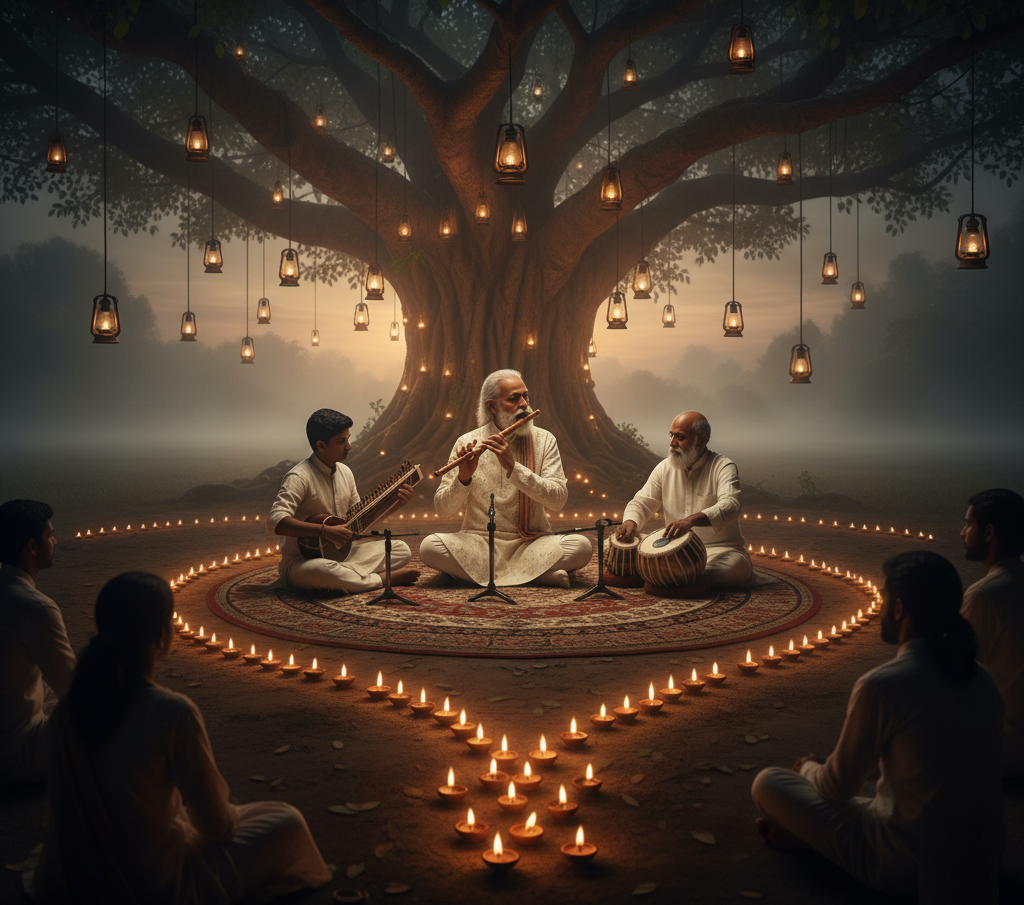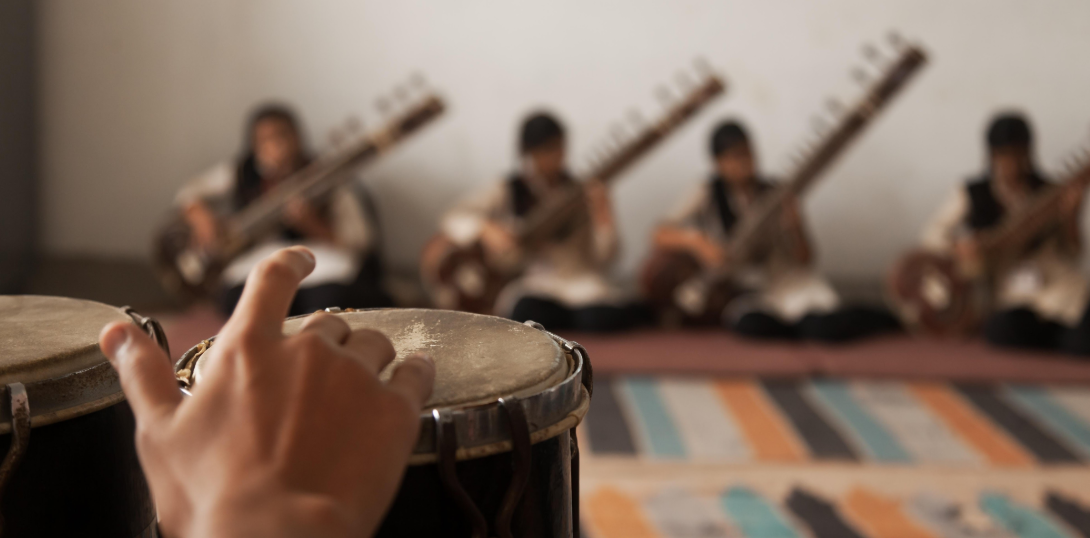Raag Aghora Kauns is a rare and deeply evocative raga that belongs to the lineage of Kauns-based melodic structures in Hindustani classical music. Known for its intense emotional depth, this raga merges the meditative calm of traditional Kauns ragas with a distinct, powerful undercurrent reflected in its tonal behavior. Although not widely performed in mainstream concerts, Raag Aghora Kauns holds a special place among musicians who appreciate ragas that challenge conventional melodic boundaries. Its combination of stillness, gravity, and spiritual weight makes it a remarkable example of how Indian classical music evolves through both tradition and experimentation.
Key takeaway: Raag Aghora Kauns stands out for its emotional intensity and its unique blend of meditative and powerful tonal elements.
Do you know?
Question: Which family of ragas is known for its mystical and meditative soundscape?
Answer: The Kauns family, which includes ragas like Malkauns, Chandrakauns, and Raag Aghora Kauns, is known for creating deep, mystical atmospheres.
Historical Background and Conceptual Roots
While the exact origins of Raag Aghora Kauns are debated among experts, the raga’s conceptual roots can be traced to the blend of spiritual symbolism associated with the term “Aghora” and the melodic framework of the Kauns tradition. The word “Aghora” is often connected to fearlessness, deep spiritual engagement, and the dissolution of duality in certain Indian philosophical schools. This connection adds a layer of conceptual richness to the raga, suggesting a soundscape that transcends the ordinary emotional register.
The raga appears to be a modern evolution rather than a classical canon raga, likely developed by musicians who sought to combine the meditative depth of Malkauns with the darker, more internalized moods of contemporary experimental styles.
Key takeaway: Raag Aghora Kauns emerges from the Kauns lineage and draws conceptual inspiration from spiritual themes associated with the term “Aghora.”
Do you know?
Question: Why do some modern ragas incorporate philosophical concepts into their names?
Answer: Many contemporary ragas use philosophical or symbolic names to reflect their emotional identity, helping listeners understand the mood and depth the raga intends to convey.
Emotional Essence and Mood of Raag Aghora Kauns
The mood of Raag Aghora Kauns is dark, meditative, introspective, and profoundly immersive. Unlike ragas that highlight romantic, joyful, or devotional sentiment, Raag Aghora Kauns explores the more inward layers of emotion—stillness, contemplation, and spiritual resolve. It often evokes a sense of solemnity and inner enquiry, making it suitable for performances that aim to create an atmosphere of depth and emotional seriousness.
Despite its darker shade, the raga is not aggressive or unsettling. Instead, it draws the listener into a quiet but powerful emotional space, where silence and sound interact with equal significance.
Key takeaway: Raag Aghora Kauns embodies a dark, introspective, and spiritually charged emotional tone.
Do you know?
Question: Which type of ragas often evoke deep introspection and solemnity?
Answer: Kauns-based ragas, including Raag Aghora Kauns, frequently create a meditative and introspective emotional landscape.

Time Theory and Performance Context
Raag Aghora Kauns is generally associated with the late-night hours, a time traditionally reserved for ragas that explore solemn, meditative, or inward-looking emotional states. Late-night ragas tend to slow the listener’s perception, allowing deeper engagement with subtle musical movements, and Raag Aghora Kauns fits naturally into this environment.
Performers often choose this raga for intimate settings, experimental concerts, or spiritual music events where its depth can be fully experienced without distraction.
Key takeaway: Raag Aghora Kauns is best performed late at night, when its introspective and solemn mood is most naturally expressed.
Do you know?
Question: Why do late-night ragas often feel more meditative?
Answer: Late-night ragas are structured to align with slower mental rhythms and the natural quietness of the night, enabling deeper emotional engagement.
Musical Structure and Note Framework
Although variations exist based on the performer’s lineage, Raag Aghora Kauns typically uses a pentatonic or near-pentatonic structure, much like other Kauns ragas. The raga usually emphasizes komal (flat) notes and employs slow, deliberate movements that support its meditative nature. The aroha and avaroha incorporate smooth glides, restrained ornamentation, and phrases designed to sustain emotional tension.
There is also a pronounced focus on tonal symmetry and controlled oscillation, helping maintain the characteristic calm gravity of the Kauns tradition while adding the distinct “Aghora” depth.
Key takeaway: Raag Aghora Kauns features a controlled, pentatonic-leaning structure with slow movements and a focus on emotional gravity.
Do you know?
Question: What makes pentatonic ragas so emotionally powerful?
Answer: Their simplicity and tonal clarity allow deeper emotional resonance, enabling performers to explore nuance without excessive melodic complexity.
Characteristic Phrases and Movement
Characteristic phrases in Raag Aghora Kauns often include long, unbroken glides, subtle oscillations on komal notes, and descending movements that draw the listener inward. The raga avoids sharp, sudden transitions and instead relies on measured, meditative progression. In many interpretations, the movement reflects a sense of gentle descent, mirroring the symbolic concept of dissolving internal layers of emotion.
Musicians emphasize the importance of silence and spacing, allowing each phrase to settle fully before introducing the next. This approach deepens the listener’s immersion in the raga’s emotional landscape.
Key takeaway: Raag Aghora Kauns is defined by smooth, meditative phrasing and controlled emotional descent.
Do you know?
Question: Why do some ragas rely heavily on descending patterns?
Answer: Descending movements often evoke calmness, introspection, and a sense of inward emotional movement, which suits ragas like Aghora Kauns.

Performance Style and Interpretation
Performing Raag Aghora Kauns requires a high level of emotional discipline and tonal sensitivity. Artists typically begin with a slow, expansive alaap that establishes the raga’s introspective identity. The emphasis is on tonal purity, controlled breathwork, and the ability to maintain emotional weight without overwhelming the listener.
Instrumentally, the raga thrives on the sarangi, bansuri, and sitar, where the natural sustain and fluidity of these instruments enhance the raga’s meditative quality. Vocal performances demand careful modulation and an unhurried delivery.
Key takeaway: Raag Aghora Kauns requires emotional control, tonal precision, and a deliberate, meditative performance style.
Do you know?
Question: Why are some ragas considered more challenging emotionally than technically?
Answer: Their impact depends on subtle emotional control rather than complex technical patterns, making interpretive depth more important than virtuosity.
Compositional Landscape
Because Raag Aghora Kauns is not a traditional raga found in older authoritative texts, the number of classical bandishes is limited. However, modern composers have explored it in contemporary classical compositions, fusion pieces, meditative tracks, and experimental soundscapes. Its restrained structure makes it suitable for atmospheric compositions and thematic performances centered around introspection and depth.
Many modern musical projects incorporate Raag Aghora Kauns into sound meditation, cinematic scoring, or spiritual performance themes due to its solemn emotional reach.
Key takeaway: Modern composers use Raag Aghora Kauns in meditative and experimental works due to its atmospheric depth.
Do you know?
Question: Why do modern composers use rare ragas in contemporary projects?
Answer: Unique ragas provide distinctive emotional colors and creative flexibility, helping composers craft fresh and memorable soundscapes.
Pedagogical Value and Contemporary Study
Raag Aghora Kauns offers significant pedagogical value for students learning emotional control, slow development, and precise tonal management. Its structure encourages disciplined breathwork, patience in delivery, and sensitivity to nuance. Because it is not bound by a rigid historical grammar, students and researchers can explore its identity through contemporary interpretations.
Scholars studying emerging ragas also find Raag Aghora Kauns valuable for understanding how modern ragas develop through philosophical influences and melodic experimentation.
Key takeaway: Raag Aghora Kauns is an important study tool for learning emotional precision and exploring modern raga evolution.
Do you know?
Question: How do new ragas contribute to classical pedagogy today?
Answer: They offer fresh frameworks for understanding melodic innovation, emotional interpretation, and evolving performance styles.
Conclusion: The Contemporary Relevance of Raag Aghora Kauns
Raag Aghora Kauns represents the evolving nature of Hindustani classical music, blending tradition with contemporary emotional exploration. Its meditative yet powerful tone, its modern conceptual roots, and its vast interpretive space make it an important raga for today’s musicians and listeners. Whether used in classical recitals, spiritual performances, or modern creative projects, Raag Aghora Kauns offers a rich and meaningful musical experience.
As more artists embrace deeper, contemplative soundscapes in today’s musical environment, Raag Aghora Kauns continues to emerge as a raga of distinct relevance and artistic depth.
Key takeaway: Raag Aghora Kauns is a modern, introspective raga that offers lasting artistic value through its emotional depth and meditative structure.
Also Read: Raag Aghali: A Complete Guide

